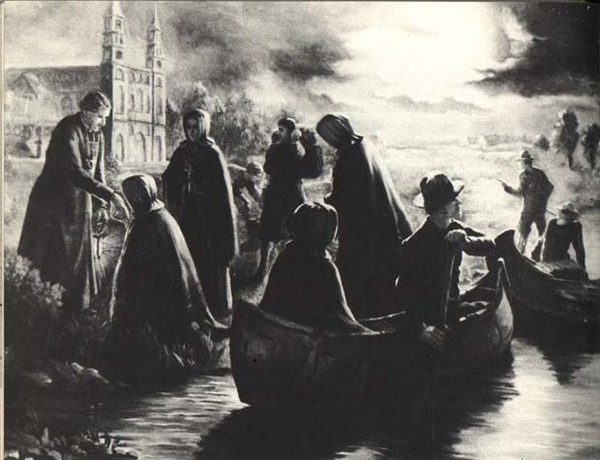- From the Red River Settlement to Manitoba (1812—70)
- Maps
- The Earl of Selkirk: The Colony’s Founder
- An Arduous Task, Marked by a Private War (1812—21)
- The Métis
- Indigenous Peoples
- Colonial Administration
- Maintaining Order and the Colony’s Defence
- Of Fur and Wheat: Subsistence and the Economy
- From Canoes to Railways: Transportation
- Life in Red River
- Missions and Religious Life
- Education, Health, and Social Assistance
- Arts and Culture
- The Press
- Intellectual and Scientific Life
- Winnipeg: The Emergence of an Urban Core
- Debating the Status of the Colony (1850—70)
- The Red River Rebellion and the Creation of Manitoba, 1869—70
- Suggested Readings on the Métis
Education, Health, and Social Assistance

Source: Link
Mathilda DAVIS was a pioneer in the field of education for girls in Red River:
“Mathilda Davis’ parents sent her to England to be educated and upon her return to Red River she devoted her life to teaching. The settlers and HBC families were at this time obliged to have their daughters educated in England as she herself had been. Now, through the efforts of influential citizens, HBC [Hudson’s Bay Company] families, and Dr. John
Sister Scholastique GOSSELIN and a group of Grey Nuns from Montreal, who established themselves at Red River as early as 1844, devoted themselves to caring for the sick:
“When Sister Gosselin arrived the community was still in its heroic period. The sisters, lodged at Saint-Boniface in a small tumble-down house where everything froze hard in winter, had to adapt themselves to a pioneer’s existence, tilling the fields and weaving their clothes. They had already begun to educate Indian children; they travelled about the countryside to help the poor and care for the sick, some of whom were brought under their roof, where the sisters organized a small hospital.”
The biography of Eleanor Eliza CRIPPS (Kennedy) provides an overview of the initiatives taken by some residents of Red River to assist individuals and families in need:
“Eleanor was unremitting in her work for the community, whether it was in arranging concerts or in sewing for the needy. During the severe grasshopper plagues of the late 1860s she organized a highly successful ‘clothing club and bazaar’ together with other Red River women to aid those in desperate want.”
A benefactor who was committed to his community, the fur trader, educator, and lawyer Alexander Kennedy ISBISTER, earned the description of “one of the finest scions of old Manitoba”:
“Isbister showed his concern for education in Rupert’s Land in a practical manner. As early as 1867 he endowed a prize for the winner of an open competition among scholars from the common schools of Red River. He left a generous bequest to the fledgling University of Manitoba: his collection of nearly 5,000 books to provide the basis for ‘a permanent Educational Library’ (unhappily most were lost in a fire in 1898) and a trust fund to establish university scholarships for ‘meritorious Students and Scholars in the various places of education in the Province for both sexes… where the highest education is given without any distinction of race, creed or nationality.’”
Please see the biographies in the following lists to learn more about the educational system, health care, and measures to assist the local population as well as philanthropy in the colony between 1812 and 1870.





